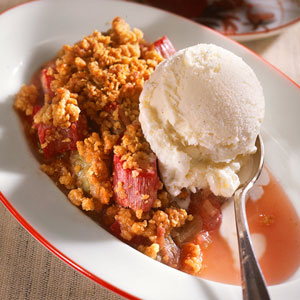
Rhubarb
For a first-time vegetable grower, there isn’t an easier place to start than with rhubarb. It will flourish without too much attention and will provide you with tasty stalks at a time when little else is ready for harvest in the garden. Cultivated for its delicious, pink stems, rhubarb is a very hardy, frost-resistant vegetable – in fact it requires a period of frost in the winter in order to produce the best stalks.
What to do
Soil preparation
- All varieties develop a deep root system and grow best in a fertile, partially shaded, free-draining soil.
- Start digging over your soil four weeks before planting, removing any stones you find and adding as much organic matter as possible.
How to plant
- Rhubarb can be grown from seed or as plants purchased from your local garden centre. Rhubarb grown from seed will take a year longer to produce stalks, and even then, the plants aren’t guaranteed to be true to type. We recommend buying one-year-old plants, known as ‘crowns’, that have been divided from strong, disease-free plants.
- Choose the right variety for your patch, prepare the soil, then plant your rhubarb in late autumn to early winter. Keep in mind that many varieties grow to be very large plants, and require a lot of space. Before planting, dig a hole with a trowel a little bit wider than the plant.
- The depth should be such that the top of the plant is at, or just below the soil surface. Gently firm the surrounding soil and water well. Spacing between plants should be about 75cm (30in) for smaller varieties, and up to 120cm (48in) for larger varieties.
- After the leaves have died down, spread a new layer of compost around the plant to conserve water and suppress weeds. Dead-head flowers immediately after they appear in the early spring, as allowing flowers to set seed will weaken the plant.
Dividing
- In order to keep the plants healthy, rhubarb should be divided every five or six years during winter, when dormant. Each plant can be split into three or four separate crowns with a spade. Make sure each crown has an ‘eye’, or a large bud that will provide next year’s shoots.
- Dig out a hole slightly larger than the divided plants and place the crown in the hole with its roots facing downwards. The top of the crown should be 2.5cm (1in) below the soil surface. Mark where the crown has been planted with a cane or stones until new shoots appear above the soil surface in late February or March.
Forcing
- This simple process provides an earlier harvest of sweeter stems that don’t need peeling. For forcing outdoors, cover plants with a container or large pot to exclude the light. Place the cover over the rhubarb as soon as it begins to show signs of growth.
- For forcing indoors, lift whole crowns in November and place them on the soil surface to be chilled for two weeks in order to break their period of dormancy.
- Pot each crown up with compost and bring into a cool greenhouse. It’s important to completely exclude any light by placing forcing pots or black polythene over crowns.
- The lack of light and the heating effect of the cover will quickly cause the rhubarb to ripen and it will be ready to eat within four weeks.
Harvesting and storage
- Allow rhubarb to establish for one year before taking your first harvest. Select three of the largest stalks, waiting for the leaves to fully open before pulling from May to August.
- Stalks are harvested by gently twisting the stems and pulling from the base of the plant. Leaves shouldn’t be eaten as they contain oxalic acid and are poisonous.
Growing tips
- Rhubarb suffers from few diseases. Crown rot is the main threat, particularly if soil conditions are wet. The fungal infection occurs at the base of the stalks where crowns turn brown and soften.
- Plants suffering from rot should be dug up and destroyed immediately. To avoid crown rot, make sure rhubarb is planted in fertile, well-drained, weed-free soil.
Five rhubarb to try
- Rhubarb ‘Ace of hearts’ – a good choice for a smaller garden
- ‘Prince Albert’ – an early variety with good long stalks
- ‘Timperley early’ – lovely flavour, good for forcing
- ‘Victoria’ – a classic allotment favourite, good for forcing
- ‘Mammoth red’ – grows up to 1.5m (5ft) high

